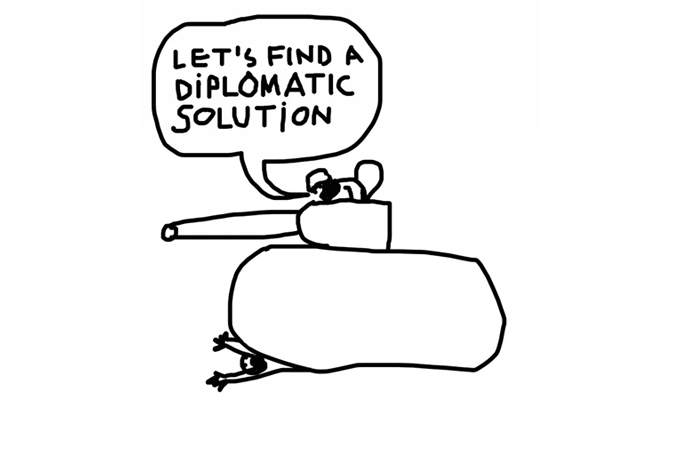Creative Time Reports: What are the inspirations for your drawings? Do they tend to be direct responses to current events or more general considerations of political issues?
Dan Perjovschi: I always start with a concrete situation or point of view taken from a daily article or breaking news report. Then I try to extract something more general and create something I can redraw years later. My wall installations include drawings I first made in 1995, and they are somehow still valid. These drawings are about the rich and the poor, a united Europe, the global and the local, the rise of China, capitalism and communism, mass surveillance and so on.
CTR: How has the Russia/Crimea narrative played out in Romanian media?
DP: Usually Romania is obsessed with itself and international news isn’t as important, but given that Ukraine is a neighboring state (with a Romanian community in the Bukovina region), the Crimean crisis was all over the media. We have never trusted the Big Bear of Russia. The independent republic of Moldova is located between Romania and the Big Bear, and with a population that is 60 percent Romanian, its official state language is Romanian. Moldova has a Crimea-like situation in Transnistria, a non-state sponsored by Russia and occupied by its army. It is also important to note we had our own Maidan protests in 1990 and last year.

Drawing by Dan Perjovschi, 2014.
CTR: Do you consider your drawings primarily comics or art? Is this a distinction that is important to you?
DP: For a while it didn’t matter, then I was a bit pissed when people called them doodles, cartoons or graffiti. Now that I’ve drawn at the Museum of Modern Art, the Tate Modern and the Centre Pompidou, I am no longer so sensitive. But the terms remain important because they can cage or expand the understanding of one’s practice. Doodles are lines you draw without thinking, like an automaton, while talking on the phone. On the other hand, cartoons or graffiti belong to an alternative or underground thinking and positioning in society. There was no such underground culture in my country because the dictatorship controlled everything.
I am neither underground nor alternative. I do not come from the streets seeking the glory of art museums and fairs. After 12 years of studying art academically, I come from the museum and move toward the street. Drawing simplified political situations in black-and-white was a conceptual and contextual decision. I consciously chose to cut out the color. And the political character of my drawings comes from working as a newspaper illustrator. For every week since 1990, I made drawings about my country’s transition from communism to membership in the European Union.
Then, at the 2008 Sydney Biennale, where I drew with chalk on the facade of the New National Gallery of South Wales, a woman in the audience told me, “Finally, some intelligent graffiti!” I liked the expression and I use it now. I define myself as an artist and a journalist whose practice is drawing. After 20 years of drawing on walls and floors, windows and Facebook, I can tell you I am very popular with both the directors and doormen of art museums.
CTR: Why do you think you’re attracted to the particular form you use?
DP: Necessity, speed and freedom. I grew up in a very poor society. Nobody would ship art in crates or pay insurance for my art to travel around. Even now the institutions in my country, as well as in the rest of the world, are facing budgetary challenges. I decided to draw directly on the wall to save myself from this bureaucratic and economic nightmare. It’s just my marker and me traveling.
I come, I draw and I go. This is a world of speed. I can do a project every week no matter where it is on the planet. You, as the audience, do not give me more than a few seconds of attention. I create art for those few seconds. If I hook you with one drawing in those seconds, then you may spend more time on my wall installation of tens or hundreds of drawings.
Humor is a medium that can create intimacy when we laugh together. At the same time, it can also create distance if we are laughing or smiling at a complicated or tough issue.
My form allows for freer practice than I would have working in other media. I draw how I want and what I want. The biennials, museums or galleries that invite me do not know what I will draw. Neither do I.


